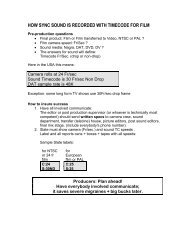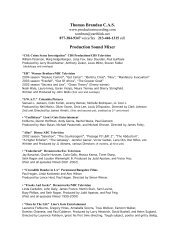NP-1 BATTERIES - Production Recording
NP-1 BATTERIES - Production Recording
NP-1 BATTERIES - Production Recording
Create successful ePaper yourself
Turn your PDF publications into a flip-book with our unique Google optimized e-Paper software.
<strong>NP</strong>-1 <strong>BATTERIES</strong><br />
Generally: The only thing that is the same about NiCad, NiMH and Lith-ion<br />
(=Lithium) <strong>NP</strong>1 type batteries is the size. The NiCads come in 12volt 1,7ah,<br />
1,8ah, 1,9ah, 2,3ah, 2,4ah. And the NiMH are 12 volt 3,5ah, 4ah, 13,2 volt<br />
3,5ah and in the USA 12 volt 4,5ah (?). The Lithium Ion is 14,4 volt 2ah and 14,4<br />
volt 2,8ah. NiCads can have 10 11 or 12 cells. NiCads have been around for a<br />
long time and can be charged by most chargers and will accept a lot of abuse.<br />
NiMH is of a higher capacity with the same weight (2,3 ah max NiCad/ 4ah max<br />
NiMH). They do require a different special charger. (NiMH do not like to be over<br />
charged.) If used with the correct charger, they should give you the same cycle<br />
life as NiCads. Aspen chargers charge both and any voltage cell, they sense the<br />
inverse Delta of charging current only, not heat. IX chargers charge all 3 kinds.<br />
The Lith-ion <strong>NP</strong>1 batteries have the advantage of weight (350grams) but are not<br />
suitable for high discharge and with a 14.4 volt nominal voltage may be too high<br />
for some equipment. Having said that, the voltage of a 10 cell (12 volt) battery<br />
NiCad/NiMH could rise to 17 volts depending on the charge rate. Lith-ion battery<br />
would be 16.4 volts max. right off the charger.<br />
The advantage of Lith-ion batteries is the weight and the low temperature<br />
capability. The Lith-ion <strong>NP</strong>1 battery would not operate your equipment much<br />
longer than an <strong>NP</strong>1-B NiCad battery but only half the time of an NiMH battery<br />
[IDX claims differently]. (Ray Pritchard www.rpmarketing.co.uk)<br />
Note: None of the manufacturers seem to select cells of the same capacity for<br />
a pack where they get charged together to increase life through uniform<br />
charging. All the manufacturers in the USA seem to use Sanyo cells. Don't<br />
expect more than 18 months out of any NiCad and that's if you use them or not.<br />
They do seem to keep capacity better if used regularly.<br />
Notes on the new Nickel-Metal-Hydride batteries: Their power capacity goes<br />
way down when the batteries are used in cold weather. They outlast Lithium in<br />
recharge cycles. They have memory and their typical lifetime used or not is not<br />
much more than 18 months. Read the IDX website for more comparisons.<br />
NiCads are cheapest! And remember all the manufacturers' specmanship forces<br />
them to lie, yes imagine that LIE! Chris Wolf says: NiMhd and NiCad fail to<br />
deliver much energy once the temperature drops below freezing. Voltagedepression<br />
problems do affect both and so, too, do cell imbalance and cell<br />
polarity-reversal effects, both of which are difficult to distinguish from "memory."<br />
Lithiums are good to –40F. Charge at room temp.<br />
Aspen: Make NiCad and NiMH Batt some with digital<br />
L.E.D. fuel gauge. Their NiCads were the cheapest<br />
($50 for 11 cell <strong>NP</strong>1 type street price) Tel.<br />
714.379.2515 Good customer phone service: (800) 241-8994. It has been said<br />
that you can go to their factory and wait for any repairs. Company has a good
eputation of looking after small customers. Nicely designed web site:<br />
http://www.aspenelectronics.com Aspen has interesting software that tests<br />
batteries in their chargers and gives you a database on their performance.<br />
FLASH: They sell a special NiMH battery that has a circuit in it that allows you to<br />
charge it from a regular NiCad charger. $160 list. Nice compact chargers that are<br />
good for both NiCads and NiMH with built in dischargers. Aspen was bought by<br />
the same company that owns Bauer in 2002.<br />
PAG<br />
10663 Burbank Boulevard, North Hollywood, CA 91601, (818)760-8265 (English<br />
made chargers) also sold by Frezzolini, (800)345-1030, are smaller and lighter<br />
and have outputs for BP-90 (round coax plug). 4 XLR pin and <strong>NP</strong>-1 adapter is<br />
available. Has diagnostic super fast refresh cycling charger that keeps a<br />
computer disk record of battery condition. PAG makes a cap for <strong>NP</strong>1 type<br />
battery with cable and 4pin. Net: http://www.pag.co.uk<br />
Anton Bauer<br />
They are the most widely used and seen chargers and<br />
batteries just because of their marketing and sales efforts.<br />
<strong>NP</strong>13 - Best price $110 at Band Pro, Burbank. (Little sales support here but they<br />
are the largest Anton Bauer dealer in the US.) Charger LS<strong>NP</strong> ($650 discounted)<br />
has 4 holes; discontinued in 2001. Charges an <strong>NP</strong>1 or <strong>NP</strong>13 batteries<br />
sequentially in about an hour + each, then sequences to charge the next battery<br />
of the 4. It comes with a manual that obfuscates how the charger works. Much<br />
blinking of red and green lights (solid green = good). Will not recondition by<br />
discharging but does all kinds of other supposedly good stuff under<br />
microprocessor control. Anton Bauer publishes a unclear battery book for free.<br />
Now on the web: http://www.antonbauer.com/handbook/handbook.html<br />
(800)541-1667 also (800)422-3473 or (203)929-1100. The national sales rep,<br />
Joe Rosado, says: We use Sanyo cells.<br />
<strong>NP</strong>1A - “centered centered cell” for longer run, shorter life - 18 Watt hr<br />
<strong>NP</strong>1B - now discontinued<br />
<strong>NP</strong>13 - “centered centered cell” shorter run, but longer life,<br />
These are good for 14-16 months with Beta, 24 Watt hr. Beta cams draw 2.2 A,<br />
PD-4 and PD-2 draw.8 A. This puts much less strain on battery and they should<br />
last a few cycles longer. http://www.antonbauer.com/<br />
Nitek1<br />
(800) 697-1122 or (510)538-5973 at 22011 Chaparral La., Castro Valley, CA<br />
94552, make a charger that works from cigarette lighter in car. Make a<br />
discharger with 10 segment LED voltmeter. 30 min. charge<br />
Frezzi Energy Systems, make NiCad and NiMH batteries and<br />
chargers, 5 Valley Street Hawthorne, NJ 07506, USA, Tel: (973)<br />
427-1160 Fax: (973)<br />
427-0934 (800) 345-1030 E-mail frezzi@frezzi.com
Cool-Lux Pro Power & Lighting<br />
Phone: (800)223-2589 and (805)482-4820, Fax: (805)482-0736 makes a variety<br />
of reasonably priced batteries and chargers. http://www.cool-lux.com<br />
These charts by Cool-Lux for CoolBrick NiCad Cells:<br />
L ithium and other rare batteries available from: http://www.tadiranbat.com/<br />
IDX make NiCad and Lithium Ion. Engineered in Japan and<br />
built there too I believe. MUST READ website explaining why<br />
Lithium is better than NiMH. For approx. $250 you get Li <strong>NP</strong>1s<br />
with a built in five segment battery meter. For around $200<br />
you get the same battery without the built in meter. Freshly charged without a<br />
load they peak at just under 16 volts. Maximum output voltage: 16.4 Volts Mean<br />
output voltage: 14.4 volts, Capacity: 50Wh (14.4V/3.2 Ah). Minimum cut off<br />
9.5V. Official temps: -14F – 122F. Charger come in 2 hole JL-2 sequential<br />
(approx $350 in 2002) and 4 hole sequential or simultaneous versions for over<br />
$1300. 8170 Ronson Road Suite C, San Diego, CA 92111 Phone: (619)560-<br />
9779 President: Pat O’Rourke ALSO IDX System Technology, Inc. 1602<br />
Lockness Place Torrance, CA 90501 Tel: 310-891-2800 Marketing: Michelle. .<br />
http://www.idxtek.com/ Dealers in Boston: Stuart Cody, in LA: LSC, Band Pro.<br />
Stuart Cody - none knows more about Lithiums and primary<br />
Lithiums than he does. Primary Lithiums are still half of<br />
rechargeables weight for the same energy. He makes them, he<br />
sells them, and consults honestly and comprehensively. He<br />
equips all film or<br />
video expeditions to cold and daring places (Everest, Artic<br />
etc…). Modifies IDX chargers for 12V. Boston (617)787-4313. A good site:<br />
http://automatedmedia.com/<br />
Information on Batteries in low temp conditions is available from Pete<br />
Bucktrout from the British Antarctic Survey on 01223 221400.
Hawk-Woods Ltd, United House, 32<br />
Brinkley Road, Worcester Park, Surrey, KT4 8JF England<br />
Tel: +44 (0)20 8715-0999, FAX: +44 (0)20 8330 5659,<br />
Good Internet site with useful info:<br />
http://www.hawkwoods.com/ They make cables that<br />
attach to an <strong>NP</strong>1: Battery to 4-pin XLR for about $60<br />
street, with the Hirose for about $150. Also make chargers and Batteries. Lithium<br />
<strong>NP</strong>-1 (430 gr. 50Watt with fuel gauge) and charger that runs on 12V as well as<br />
110-220V. Make RF receiver holders for various sizes.<br />
R.P.Marketing, Ray Pritchard,<br />
http://www.rpmarketing.co.uk<br />
RP Marketing Sales Tel: +44 (0)1787 278983 Fax: +44<br />
(0) 1787 278997 Mobile: 0973 769847 Email:<br />
ray.apt@lineone.net They make very flexible fast<br />
chargers (12V and 90-220 input) for <strong>NP</strong>1 of all<br />
persuasions. Their batteries have microprocessor<br />
controlled capacity indicators. They makes 50 Watt NiMH batteries with five LED<br />
charge indicators. He also makes 1, 2, and 4 channel chargers. He also makes<br />
NiCad and Lithium <strong>NP</strong>1's. He used to work for IDX in the UK.<br />
de=Li-856N<br />
SWITRONIX A new company based in Nanjing, P. R.<br />
China with some interesting engineering: NiCad, NiMH<br />
and Lithium. Li-Ion <strong>NP</strong>1 called Li-856N claim 56 WH 14.4 V.<br />
1-800-613-SWIT http://www.switronix.com/ or www.switbattery.com<br />
and<br />
http://www.walkart.net/english/productdetail.asp?productco<br />
Batteries FAQs - all there is to know about heavy batteries at:<br />
http://www.dcbattery.com/ Brands: Optima, Lifeline, Powersonic, not Panasonic,<br />
not Hawker.<br />
Panasonic has decent info CD they will send you or batteries on the net:<br />
http://www.panasonic.com/industrial/battery/oem/chem/seal/index.html<br />
Interesting NiCad info:<br />
http://www.repairfaq.org/ELE/F_NiCd_Battery.html#NICDBATTERY_025<br />
Complete Battery sales of all kinds and accessories and custom assembly on<br />
web (shipping from MA): http://www.advanced-battery.com/<br />
Car and Deep Cycle (Sealed Lead-Acid) Battery Frequently Asked Questions<br />
(F AQ) maybe found at http://www.uuhome.de/william.darden/ Also, has a<br />
Battery Manufacturers and Brand Names List, Battery References and<br />
Information Links.
Battery charger controller for solar panels:<br />
http://www.solarconverters.com/index.html<br />
Current prices 2003: Nicad <strong>NP</strong>-35 14V 2.4 Ahr $113.75, <strong>NP</strong>1-BEQ 13V 1.9 Ahr<br />
$61.25, 12V 2.4 Ahr NiMHd IDX <strong>NP</strong>-23DX $86.25, IDX <strong>NP</strong>-1 Lithium $186.<br />
About discharging NiCads:<br />
Larry Fisher writes: First : the easiest way to discharge <strong>NP</strong>-1 is with the Aspen<br />
RoQ-4 charger that has a discharger built in that stops at the correct voltage and<br />
with a $50 computer prog. and cable will keep track of your batteries and their<br />
condition over their lifecycle. [Unfortunately their software requires a win 95<br />
machine. Hard to find these days. Ed].<br />
A safe way to discharge a Batt pack ( 10 – 13 cells in a <strong>NP</strong>-1) to a fairly low<br />
level is to put a digital volt meter (DVM) on the pack and keep a eye on the<br />
voltage. Near the endpoint of the discharge cycle, you will see a sudden (over<br />
less than a minute) 1.2 volt drop in the battery voltage as the weakest cell goes<br />
from 1.2 volts to 0 volts. Stop discharging the battery at that moment, before the<br />
weak cell can go into a reversed condition. If you continue discharging the<br />
battery, you will see additional 1.2 volt steps as more cells go to 0 volts. Do not<br />
miss this point or you will ruin the battery.<br />
I think the smart chargers, when run in a renewal mode, discharge the pack and<br />
look for that sudden 1.2 volt drop. [Some just look for the overall voltage of a<br />
pack say 6 (cells) x 1.0 volt = 6.0V min. for a 6V battery. This is the voltage you<br />
should stop discharging if no 1.2V drop had occurred first.]<br />
The notion that “memory effect” is nonexistent is correct, crystallization<br />
is what<br />
reduces the capacity of a still good NiCad. Crystallization occurs over time and<br />
can occur whether a battery is being trickle charged or stored, in a charged or<br />
discharged state. We (Lectrosonics) used to receive batteries in a fully<br />
discharged state from high quality manufacturers and they all had about 70%<br />
capacity on the first charge - discharge cycle. After that first cycle they would<br />
meet their rated capacity but would make about 120% capacity after a few more<br />
cycles. Crystallization is reversed by battery usage. A full discharge will reverse<br />
crystallization in the quickest way but may ruin a pack. Substantial partial<br />
discharges (80% discharged to choose a number) will accomplish the same thing<br />
but it may take 3 or 4 cycles before the battery is reformed to full capacity. My<br />
experience is that an 80% discharge every month will keep a battery in good<br />
shape without running the danger of reversing a cell. I have no scientific basis for<br />
that statement. [Generally people agree that NiCads that are used regularly last a<br />
lot longer than ones on the shelf a lot]. Like people, occasional [monthly]<br />
not<br />
strenuous exercise will keep a NiCad in good shape, just don't overdo it. [Do<br />
discharge to less than 1V per cell].<br />
As the experienced and exhausted NiCad users know, full discharges won't<br />
damage a battery pack every time it is done or even once every ten times. As the<br />
packs<br />
get older and the cells become more and more unbalanced in capacity, the
probability of shorting one does increase. Heavy discharges to low voltages<br />
[below 1V per cell] will eventually catch up with you.<br />
One last thought: use caution when discharging or using a NiCad pack. They<br />
can deliver frightening amounts of current, on the order of hundreds of amps.<br />
A well charged one amp 12 volt battery pack weighing one pound can turn a<br />
piece of number 18 wire red hot much faster than you can let go of it. Most<br />
commercial packs are fused but don't depend on the fuse. You can be<br />
burned down to the bones experimenting on yourself.<br />
Batteries in cold:<br />
Lithiums rechargeable are pretty good at low temperatures and would be the best<br />
choice. NiCads are great when cold but their capacity is much less than the<br />
lithiums to begin with. If you do recharge NiCads or NiMH's, be aware that they<br />
will discharge well at low temperatures but they won't recharge worth a dang<br />
when cold. The cell won't accept a charge and the current forced into the battery<br />
causes electrolysis of the electrolyte and the battery will overpressure and vent.<br />
When charging always bring batteries to room temp.<br />
Above written by Larry Fisher Lectrosonics larryf@lectrosonics.com<br />
LITHIUM <strong>BATTERIES</strong>: 9V<br />
So here's the bottom line about Lectrosonics position on 9 Volt lithiums for Radio<br />
Mike transmitters: Buy Ultralife branded batteries, keep them in the foil pouch<br />
until you are ready to use them (a few months in open air does no harm,<br />
however). One little trick, if you are using 9 V lithiums in RF transmitters. The<br />
batteries swell as they are discharged and at full discharge some of the double<br />
foil wrapped batteries will stick in the transmitters and can be difficult to remove.<br />
Not all the batteries are double wrapped but you can make them easy to remove<br />
if you peel the foil off before you insert it in the transmitter. That way you also<br />
know the battery has been used. The swelling is pretty extreme and is easily<br />
visible to the eye. Larry Fisher Lectrosonics larry f@lectrosonics.com<br />
9 VOLT BATTERY LIFETIME IN RF MIKES<br />
Here some practical battery tests: we used the same transmitter, a Lectro UM200<br />
for all the testing. This is a 100 mW UHF belt pack transmitter. This particular<br />
unit pulled 75 mA. We ran four different kinds of batteries to a final voltage of<br />
both 7.0 and 6.6 Volts. 7.0 Volts is where the LED is pretty dim and where two of<br />
our receivers with battery readouts start indicating low battery and 6.6 Volts is the<br />
very low battery indication. The transmitter is getting close to completely dying at<br />
6.6 Volts but will usually run to 6.4 Volts or less. The LED goes out totally at 6.8<br />
Volts. So I'll list the type of battery and then the very dim LED point (7.0 Volts)<br />
and then the maximum use (6.6 Volts).<br />
Ultralife Lithium<br />
Duracell Ultra Alkaline<br />
16.0 hours and 17.2 hours<br />
6.5 hours and 8.25 hours
Eveready Alkaline<br />
4.75 hours and 6.75 hours<br />
Varta NiMh rechargeable 2.5 hours and 2.5 (!) hours<br />
Varta after 2 months of sitting around is the same as above, 2.5 hours.<br />
Here's my conclusions: Assuming that a sound mixer with good common sense<br />
would toss a battery when the LED is very dim (or sooner) and using a standard<br />
alkaline as a reference, you'll get 3 times the life with a lithium, about 40% more<br />
life with an Ultra alkaline and about one half the life with a top quality nickel-metal<br />
hydride (NiMh) battery. ( Though the Varta NiMh claims only 150 mAh, they start<br />
out at more than 180 mAh.) Also, the NiMh batteries don't self discharge as<br />
quickly as NiCad batteries since the battery after sitting for two months was still<br />
at close to full capacity.<br />
Anti-disclaimer section: Most brands of alkaline batteries are nearly the same,<br />
alkalines and lithiums have a long shelf life, and our transmitters are pretty<br />
consistent. In any case, the ratios of battery life should be good numbers. You<br />
guys know what kind of battery life you are getting now, and the ratios should be<br />
informative.<br />
From: Larry Fisher (larryf@op eramail.com )<br />
AA <strong>BATTERIES</strong> NIMH<br />
Here's the tests on some AA NiMh batteries that have the highest capacities that<br />
I'm aware of. We tested with 3 Ohm loads across the batteries and measured the<br />
time. Eyeballing the graphs, we assumed an average voltage of 1.22 Volts for a<br />
407 mA current drain. The 1.22 Volts was a good average since NiMh fall from<br />
1.35 Volts pretty quickly, hang around 1.25 Volts for some time drooping towards<br />
1.2Volts and then fall quickly to .9 Volts where we shut down the test and took<br />
our times.<br />
Under optimum charging and full discharges, the iPwr batteries averaged 4.85<br />
hours for a capacity of 1900 mAh, slightly under the claimed minimum of 2050<br />
mAh or 93% of claimed value. This could be different test protocols, etc.<br />
The Eveready batteries also averaged 4.85 hours for the same 1900 mAh versus<br />
a claimed 1800 mAh. The Eveready did take one more cycle to reach the best<br />
numbers. May be a difference in the age of the batteries.<br />
Without going into real details,<br />
1. The batteries increased in capacity after a full charge discharge cycle or two<br />
and the batteries might do slightly better after a few more cycles but it would be<br />
small.<br />
2. Trickle charging or fast charging plus a trickle charge cycle produced about<br />
10% more capacity than taking a battery directly out of a fast charger while still<br />
warm.
We used a Maha fast charger C-204F for the fast charging and fast charging plus<br />
trickle. http://www.mahaenergy.com/products/PowerEx/Digicams/batteries.htm<br />
We used the Eveready trickle charger for trickle only. It shuts of after a 15 hour<br />
timed charge cycle. You can find the Eveready at Walmart and other places.<br />
They look like a good deal. The Maha chargers also have a good reputation on<br />
the web.<br />
Today (2003) Rayovac AA may be the fastest charging:<br />
h ttp://www.rayovac.com/busoem/oem/index.shtml Larry Fisher, Lectrosonics<br />
At WSV we use the Lenmar AA batteries with their 1 hour chargers just because<br />
they are easy to get at Fry’s and they are dirt cheap.<br />
APC Uninterruptible Power Supply also make real sinewave UPS with $25,000<br />
lifetime equipment warranty. (the warrantee is the most valuable thing in the film<br />
bizz, you know how often you get shitty power) some are rackmount<br />
http://www.apcc.com/resource/include/techspec_index.cfm?base_sku=PS250<br />
this one is not sine wave, totally configurable with several alarm configuration.<br />
Automatic Voltage Regulation (AVR), Building wiring fault indicator, Hot Swap<br />
Batteries, Intelligent Battery Management, Overload Indicator, Rack Mount,<br />
Replace Batt Indicator, Software, User Replaceable batteries, Wide input voltage<br />
range. Excellent tech help including automated notification of lightning strikes in<br />
your area. Sine wave inverters are called SMART UPS<br />
http://www.apcc.com/products/family/index.cfm?id=165<br />
750 VA at $ 450<br />
http://www.apcc.com/resource/include/techspec_index.cfm?base_sku=SUA750R<br />
M1U&language=en&LOCAL.APCCountryCode=US<br />
Here is the warranty:<br />
http://www.apcc.com/support/service/equipment_protection_policy.cfm Great<br />
run time chart<br />
http://www.apcc.com/products/runtime_by_family.cfm?upsfamily=165 and they<br />
have excellent white papers to study. Call to ask for recharge times, excellent<br />
telephone service.<br />
Exeltech http://www.exeltech.com/ sine wave inverters some for military<br />
Battery sales on web: http://www.advanced-battery.com/ have<br />
many unusual configurations incl. Lithium and NiMH AA and<br />
chargers, specialize in custom construction. (800) 634-8132<br />
Advanced Battery Systems, Inc., 310 Tosca Drive, Stoughton, MA<br />
02072, (781) 297-3894<br />
Lenmar Batteries and holder for Lithiums and DV<br />
and anything else imaginable for consumer gadgets:<br />
http://www.lenmar. com/plate_request.asp
Sol ar chargers, large variety in ready to use configurations:<br />
http://www.solardyne.com/solarpvpanels.html<br />
LEAD ACID SYSTEMS:<br />
Astron makes solid industrial power supplies (with fans) good for floating<br />
batteries that supply up to 20A and 12V DC to 110V AC inverters we use and sell<br />
for 20 years<br />
http://www.astroncorp.com/<br />
http://www.iotaengineering.com/dls.htm make high wattage up to 75<br />
A 12V power supplies good for floating batteries that supply heavy<br />
current. Small fan<br />
Xenotronix in Florida now make good industrial chargers no fans, no power<br />
supplies. We use and sell these for 20 years, Chargers more so than electronics<br />
that don’t ge t hot as all hell need to be checked annually for proper operation or<br />
you ruin many batteries.<br />
http://www.<br />
xenotronix.com/products/leadacid/leadacid.htm<br />
Lead Acid Battery source Advanced Battery Systems, 1639 11th Street<br />
Suite 102, Santa Monica, Ca 90404 , Phone: 310-450-1630, Toll Free 800-<br />
464-4796 some Panasonic some Optima<br />
http://www.absbattery.com/optimamainpg.htm and mafct.<br />
http://www.optimabatteries.com/ the best but start at 55Ahr – 40 pounds. Pep<br />
Boys 4520 South Sepulveda Blvd Culver City, CA 90230<br />
How to regulate and control voltages and build power supply:<br />
h ttp://www.zen22142.zen.co.uk/ DC-DC Meanwell power supply:<br />
http://computronics.com.au/meanwell/scw/<br />
this is from my book:
Sound for 24P<br />
270 page Bound book, many flow diagrams and pix © Wolf Seeberg new 9 th edition Feb. 2004<br />
A hands-on manual written by a Hollywood sound recordist for on set personnel and producers.<br />
The argument the book makes is for double system sound even with the new video cameras.<br />
Sound on video tape is not reliable, especially with the F900. The book explains how to record<br />
sound and timecode onto digital video tape and make a parallel higher confidence recording on<br />
DAT or DVD that holds sync in the final ON-LINE edit and “sweetening”. It details timecode<br />
procedures for 23.97 and includes: flow diagrams of signal distribution; afterburners; audio<br />
delays, requirements for video assist; internet sources; latest shortcuts to bring down post<br />
production costs and maintain highest quality, secret menu functions and useful additions to<br />
manufacturers manuals. Manufacturers manuals are reproduced, corrected and annotated.<br />
Links to the web abound. This book gives guidelines for producers to sort out inevitable<br />
squabbles. If you work in film/video sound with the new 24P video cameras, then this is a musthave<br />
reference book. There is more in this book than any one person will ever know. Latest<br />
details for the Sony HDW-F900 and the HDWF-500 deck, Panasonic AJ-HDC27V, Viper, and<br />
Panasonic DV cam AG-DVX100.<br />
LIST PRICE ONLY $36.00<br />
Order it on the web:<br />
www.coffeysound.com/store/books.html<br />
http://www.locationsound.com/proaudio/ls/SBOK0002.html or<br />
http://www.trewaudio.com/catalog/items/item96.htm
SYNC SOUND<br />
280 page Bound book, many photos, new 8 th edition © Wolf Seeberg 2004<br />
A hands-on manual written by a Hollywood veteran sound recordist for location sound mixers and<br />
post personnel. All of the DAT, DVD and analog timecode tricks for syncing film or video are<br />
explained giving everyday useful hints: Transfer to video tape, 3:2 "pull up” and “pull down” and<br />
speeds of 60.05, 60, 59.94, 30, 29.97, 25, 24.02, 24, 32, 42.336, 44.056, 44.1, 44.144, 45.937,<br />
46.0801, 47.952, 48, 48.048, 50. All of the new and legacy machines are covered: HHB PDR<br />
1000TC MS, Fostex PD-2, PD-4, PD-6, DEVA II, Sony D-8, Sonosax, Nagra IV-ST, Nagra TC<br />
conversions, Sony 7030, DA-88-98, and Aatons Origin C, Denecke and Ambient Products.<br />
Unique capabilities and bugs, detailed technical instructions and unpublished menus and<br />
warnings are featured. Video and computer screen synchronizing with film cameras at 24, 25,<br />
29.97 and 30 fr/s, video sync boxes for 24 frame monitors are explained. Sources on the Internet<br />
are provided. This is a "how to do it" manual with an easy-to-grasp explanation of underlying<br />
theory. If you work in the film/video field and sync is of interest, this is a must-have reference. If<br />
you are a producer and want to prevent wasting big bucks in post, make your staff read this!<br />
List Price still $36.00<br />
Excerpts from both books: http://syncsound.trewaudio.com<br />
Available from:<br />
Location Sound Corporation (818)980-9891,<br />
10639 Riverside Drive, N. Hollywood, CA 91602, locationsound.com<br />
Coffey Sound (323) 876-7525, fax (323) 876-4775<br />
3353 Cahuenga Blvd. West, Hollywood, CA 90068, CoffeySound.com<br />
Trew Audio Inc. (800) 241-8994 or (615)256-3542,<br />
240 Great Circle Road, Ste. 339, Nashville, TN 37228-1707, trewaudio.com<br />
Fletcher Chicago (312) 932-2700 Fax: (312) 932-2799,<br />
1000 N. North Branch Chicago, IL 60622, fletch.com<br />
Gotham Sound & Communications, Inc. (212) 629-9430, fax (212) 629-9436<br />
330 W. 38th St., Ste. 608, New York, NY 10018, gothamsound.com<br />
Southeast Audio Services, (800) 562-8346, (800) 56 AUDIO,<br />
1771 Blount Rd., Ste. 206, Pompano, FL 33069, seaudio.com<br />
03/02/04


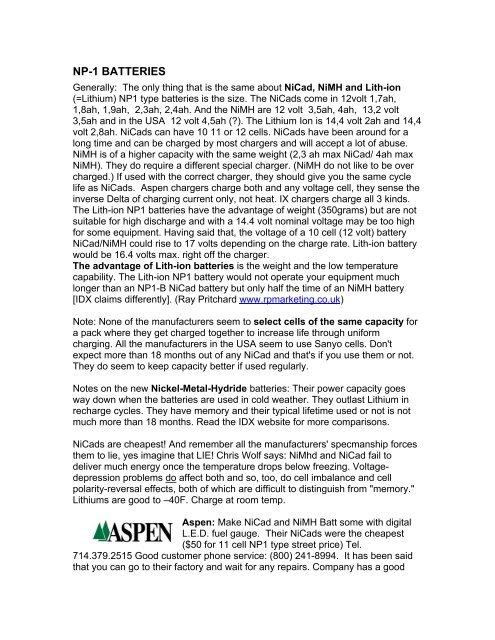
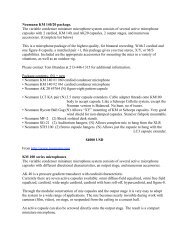
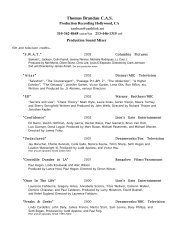
![[Wolf Seeberg on NP-1 Batteries] - Production Recording](https://img.yumpu.com/24136891/1/190x245/wolf-seeberg-on-np-1-batteries-production-recording.jpg?quality=85)
